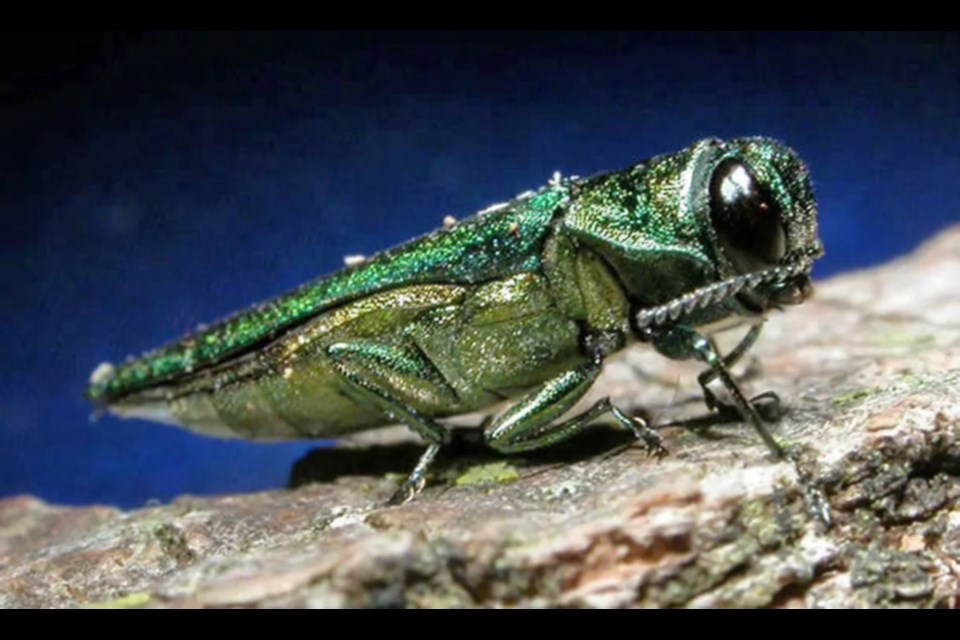The battle with the emerald ash borer continues in Guelph and surrounding areas and the city urges residents to watch for signs of infestation on their properties.
“Many of the community’s ash trees are located on private land,” says Timea Filer, an urban forestry field technologist with the City of Guelph.
“It is important that residents recognize that they share some responsibility in mitigating the EAB infestation in order to protect and preserve Guelph’s urban forest and that they are responsible for the maintenance of trees located on private property and the related risks to people and property.”
Filer asks that if anyone suspects that an ash tree on their property is infested to contact a certified arborist or tree care company to arrange an inspection.
City staff are also available to provide information and guidance.
If trees are left untreated, ash trees will die from infestation and a dead or dying tree can become a hazard to people and their property.
The emerald ash borer was first confirmed in the south end of the city in the fall of 2011.
Filer says that EAB is now well established throughout the city and it is expected that close to 100 per cent of Guelph’s untreated ash trees will die over the next two to four years.
The insect is native to China and eastern Asia and is a highly destructive wood-boring beetle which feeds under the bark of ash trees.
EAB was discovered in North America in 2002.
“All species of ash are susceptible to attack, except mountain ash which is not an ash species,” Filer said.
“The EAB has killed a large number of ash trees in Canada and in the United States and poses a major economic and environmental threat to urban and forested areas.”
The city is currently in its sixth year of a 10-year plan (2014-2023) to try to get a handle on EAB infestation of city-owned trees.
Filer says this includes inventory, monitoring, treatment, removal, replacement of trees, communication and public outreach.
According to the city, the basic principles of the plan are to: ensure the safety of people and property, reach out to the community to raise awareness of the issue and to provide them with options, treat as many ash trees as feasible investing in only the best candidates and to set recovery into motion as quickly as possible, even before ash trees decline.
The plan also outlines the need to protect natural areas from ecological degradation and to leave infested but ‘green’ city-owned ash trees standing, as long as it is safe and reasonable to let them stand - to gain the longest ‘service life’ from each mature ash.
Signs of infestation include a thinning crown, diminished density of leaves, evidence of adult beetles feeding on leaves, long shoots growing from the tree trunk or branches, vertical cracks in the trunk, small D-shaped exit holes and S-shaped tunnels under the bark, filled with sawdust.
EAB can fly several kilometres and can spread even further when people move firewood, trees, wood chips or logs.
Guelph’s EAB plan includes the treatment, removal and replacement of city-owned ash trees.
“Over the last five years, the city has seen increased removal, disposal and replacement of trees on streets, in parks and natural areas,” Filer said.
“In total, 1074 ash trees have been removed from streets and in parks since 2014. Most currently, 4,324 ash trees in forested natural areas were removed in order to maintain public safety.”
According to the city, city-owned ash trees showing signs and symptoms of EAB infestation will be removed and replacement trees will be planted. Trees are only removed if they are dead or in serious decline.
Ash trees not showing signs of infestation, will be assessed for possible treatment of TreeAzin, a natural pest control product registered under the Pest Control Products Act. The product has been successfully used in Guelph, surrounding municipalities, the Grand River Conservation Authority and private landowners.
Filer is no stranger to the product.
Holes are drilled at the base of the tree where the TreeAzin is injected and the chemical is taken up the tree by the leaves. The trees might not fully recover but the product does help maintain the health of the tree.
The city has predicted a budget of $4.2 million to treat, remove and replace infested ash trees on city-owned property.
But the ash trees on private property also remain a problem as the city continues to remind residents to deal with any infestation to avoid the risk of spread.
“There are things residents will need to do during the course of infestation,” Filer says.
Property owners should have their ash trees assessed by an arborist to see if they should be treated or removed.
“They need to check their property for ash trees, inspect ash trees for signs of infestation, treat the ash trees if they are in good condition, remove trees that are dead or dying before they become a hazard and replant with native trees. Removal of infested ash trees is not effective for controlling the spread of EAB but residents can slow the spread by not moving live ash material or wood from removed ash trees infested with EAB,” Filer said.
For the city, its about preserving the city’s tree canopy and this includes city-owned and non-city owned trees.
“Moving forward, efforts will continue on maintaining public safety,” Filer said.
“But there will be increased efforts on replacing removed ash trees and restoration plantings in natural areas.”



